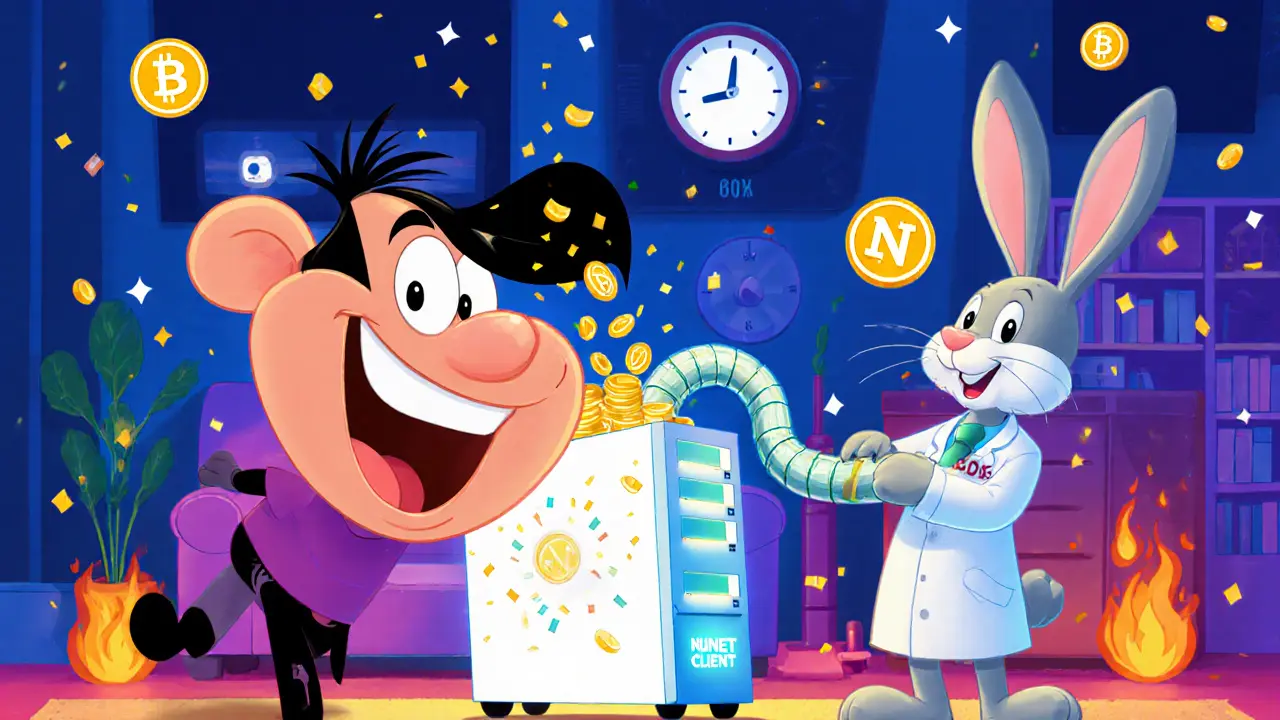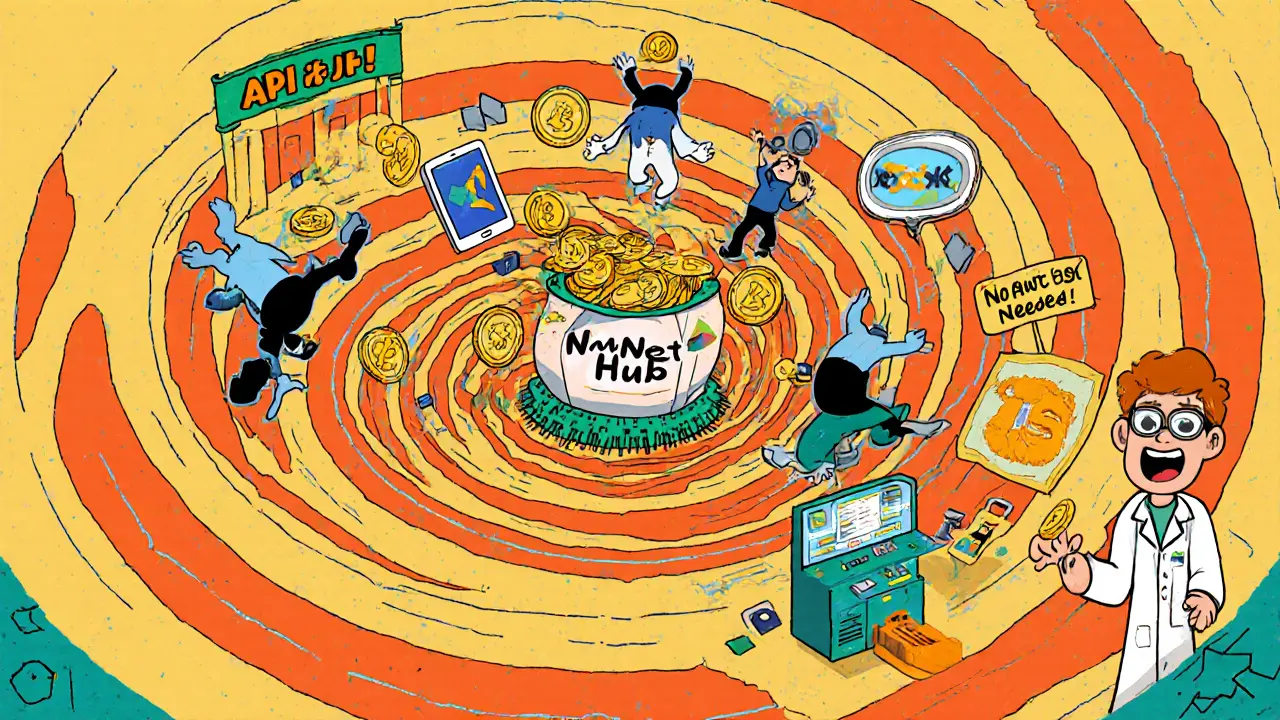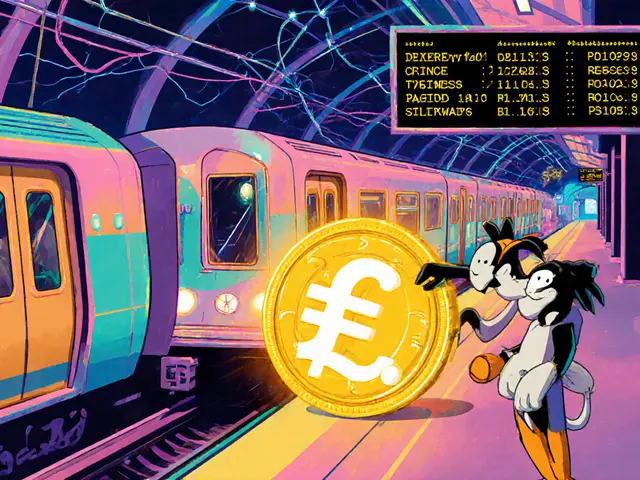
NTX Earnings Calculator
How Much Could You Earn?
Estimate your potential NTX earnings from sharing idle computing resources with the NuNet network.
Estimated Earnings
Based on current NTX price of $0.0065
Actual earnings may vary based on network demand
NuNet (NTX) isn't just another cryptocurrency. It’s a utility token built to turn your unused computer power into cash. Imagine if you could rent out your spare CPU, GPU, or storage space-just like renting out a spare room-except it’s for AI models, scientific calculations, or video rendering. That’s exactly what NuNet does. Launched on November 16, 2021, it’s the first project to come out of the SingularityDAO Launchpad and is tied to the same team behind SingularityNET, a well-known name in decentralized AI.
How NuNet Works: Turning Idle Tech Into Income
NuNet connects people who have extra computing power with those who need it. Think of it like Uber, but instead of cars, you’re sharing your laptop’s processing power. If you’re running a PC at 30% usage, NuNet’s software can quietly use the other 70% to help train AI models or run simulations. In return, you earn NTX tokens.
It’s not just for desktops. The system works on smartphones, IoT devices, and even small data centers. The platform uses AI to match tasks with the right hardware automatically. No need to be a tech expert. Install the client, let it run in the background, and get paid. For users who need computing power-like AI startups or researchers-they pay in NTX to access this global pool of resources.
The NTX Token: More Than Just a Currency
NTX is the lifeblood of the NuNet ecosystem. It’s not just used to buy computing power-it’s also how providers get paid and how users vote on future upgrades. The token has a fixed supply of 1 billion NTX. Half of it (631 million) runs on Ethereum as NTX-ETH, and the other half (369 million) runs on Cardano as NTX-ADA. Both versions are 1:1 interchangeable, so you can move them between chains without losing value.
When NuNet launched, the private sale price was $0.02 per token. That gave the project a $20 million fully diluted valuation. Today, as of November 2025, NTX trades around $0.006-$0.007. That’s down from its all-time high of $1.02, but it’s important to remember: this isn’t a speculative coin like Dogecoin. Its value comes from actual usage. If more people start renting out their computers or buying compute power through NuNet, the demand for NTX will rise.
Why NuNet Stands Out From Other Decentralized Computing Projects
NuNet isn’t the only player in decentralized computing. Golem (GLM), Render Network (RNDR), and Akash (AKT) also let you rent out computing power. But NuNet’s edge is its "API of APIs" design. Instead of competing with other platforms, it connects them. If you’re using Render Network to render a 3D animation, NuNet can also pull in spare power from Golem or Akash to speed things up-all under one roof.
This makes NuNet unique. It doesn’t try to build the biggest network. It tries to be the central hub that makes all networks work better together. For developers, that means one API to access the entire decentralized computing world. For users, it means more jobs and better pay because demand is spread across a bigger pool.

Market Reality: Small But Growing
NuNet’s market cap is around $3.2 million as of late 2025. That’s tiny compared to Render Network’s $850 million or Golem’s $120 million. It’s ranked #1496 on CoinMarketCap. That doesn’t mean it’s failing-it means it’s early. Most decentralized computing projects took years to gain traction. NuNet’s biggest advantage? Its roots in SingularityNET. That means it already has access to a community of AI developers who need distributed computing power.
Right now, trading volume is low-around $128,000 in 24 hours. But that’s typical for niche projects. The real test isn’t how much it’s traded today, but whether people are actually using it to run AI models or rent out their machines. Early reports suggest adoption is growing slowly among indie AI developers and research labs that can’t afford AWS or Google Cloud.
Who Should Care About NuNet?
If you’re a hobbyist with a gaming PC or a laptop that sits idle, NuNet lets you turn that into passive income. You don’t need to mine Bitcoin or stake Ethereum. Just install the software and let it run.
If you’re a startup building AI models, NuNet offers a cheaper, more flexible alternative to cloud giants. Instead of paying $50/hour for a high-end GPU on AWS, you can rent one for a fraction of the cost from someone in Poland or Brazil.
If you believe in decentralizing tech infrastructure-taking power away from Amazon, Microsoft, and Google-NuNet is a real experiment in that direction. It’s not perfect. It’s not mainstream. But it’s trying to solve a real problem: 80% of global computing power sits unused.

Challenges and Risks
NuNet isn’t without risks. The token’s price has dropped over 98% from its peak. That scares off some investors. But price isn’t everything. Bitcoin’s early price swings were wild too. What matters is whether the network grows.
Another hurdle: most people don’t know about it. You won’t find NuNet on Robinhood or Cash App. You need to use a crypto exchange like MEXC, Gate.io, or KuCoin. And you need to understand how to use a wallet compatible with Ethereum and Cardano.
There’s also no guarantee NuNet will win. Big tech companies are starting to offer decentralized compute options too. If Microsoft or Google launches a similar service with better support, NuNet could struggle. But for now, it’s one of the few projects focused on truly open, peer-to-peer computing.
How to Get Started
Here’s how to join NuNet in 3 steps:
- Get a wallet that supports both Ethereum and Cardano. MetaMask works for ETH. Nami or Flint works for ADA.
- Buy NTX on exchanges like MEXC, Gate.io, or KuCoin. Search for "NTX" and pick the right chain (ETH or ADA).
- Install the NuNet client from nunet.io. Run it on your PC or server. The software will auto-detect available resources and start earning NTX.
If you’re a provider, you’ll earn based on how much power you contribute and how long you stay online. If you’re a consumer, you can pay for compute time using NTX tokens. The system handles pricing, security, and payments automatically.
The Bigger Picture: Why This Matters
The global computing market is worth over $15 billion-and growing fast. Yet most of it is controlled by five companies. NuNet wants to change that. It’s not about replacing AWS. It’s about giving people a choice. A choice to earn from their own hardware. A choice to avoid corporate monopolies. A choice to power the next generation of AI without being locked into a contract.
NuNet is still small. But small projects have changed the world before. Ethereum started with a $10 million valuation. Bitcoin was worth less than a dollar for years. What matters isn’t where NuNet is today-it’s where it could be if more people start using it.
Right now, the network is quiet. But if you’re looking for something real-not hype, not memes, not pump-and-dumps-NuNet might be one of the few crypto projects actually building the future.
Is NuNet (NTX) a good investment?
NuNet isn’t a typical investment. Its value comes from usage, not speculation. If more people rent out their computers or buy compute power through NuNet, NTX will become more valuable. But if adoption stays low, the price may stay flat or drop further. Only invest what you’re comfortable losing.
Can I mine NuNet (NTX)?
No, you can’t mine NTX. It’s not a proof-of-work coin. Instead, you earn NTX by contributing unused computing power-CPU, GPU, or storage-to the NuNet network. The more you contribute, the more you earn.
Where can I buy NTX tokens?
NTX is available on exchanges like MEXC, Gate.io, KuCoin, and Bitrue. You won’t find it on major platforms like Coinbase or Binance. Make sure you’re buying the right version: NTX-ETH (Ethereum) or NTX-ADA (Cardano).
Does NuNet work on phones?
Yes. NuNet’s software can run on Android phones and tablets with sufficient processing power. However, battery life and heat management are concerns. Most users stick to desktops or servers for consistent earnings.
How does NuNet compare to Golem or Render Network?
Golem and Render focus on their own networks. NuNet connects them all. If you’re using Render to render a video, NuNet can also tap into Golem’s spare power to speed it up. It’s a meta-marketplace, not a competitor. That makes it more flexible but also more complex to build.
Can I stake NTX to earn more?
Yes, staking is possible. Token holders can lock up NTX to help secure the network and earn additional rewards. The exact APY depends on network participation and is set by community vote. It’s not as high as DeFi staking, but it’s a way to earn without contributing hardware.
Is NuNet safe to use?
Yes. NuNet uses blockchain encryption and sandboxing to protect your device. The software only accesses idle resources and can’t touch your files, passwords, or personal data. It’s designed like a background app-safe, silent, and secure.
What’s the future of NuNet?
NuNet’s future depends on adoption. If AI developers start using it for model training, and regular users start contributing their idle hardware, it could grow quickly. Its link to SingularityNET gives it a strong starting base. But it needs real users-not just speculators-to succeed.





